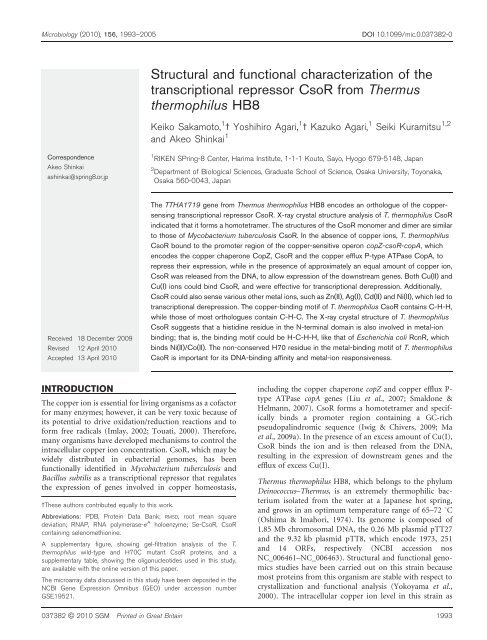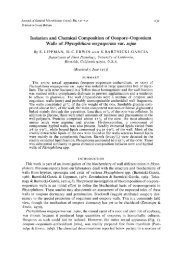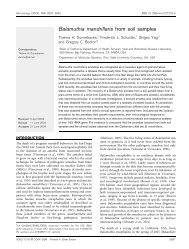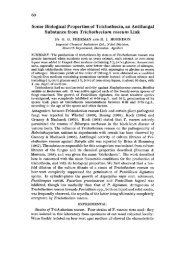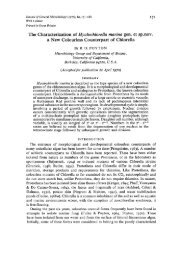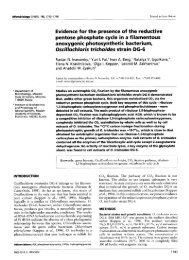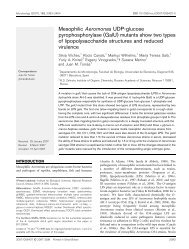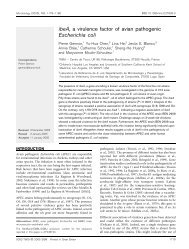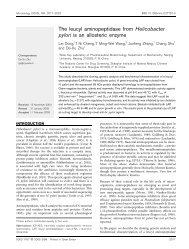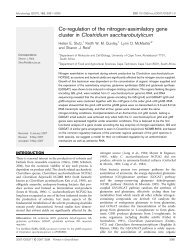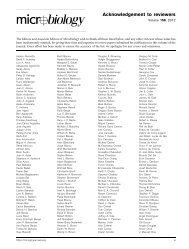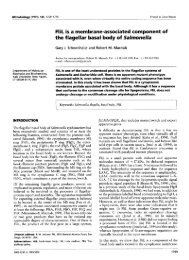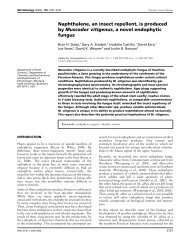Structural and functional characterization of the ... - Microbiology
Structural and functional characterization of the ... - Microbiology
Structural and functional characterization of the ... - Microbiology
You also want an ePaper? Increase the reach of your titles
YUMPU automatically turns print PDFs into web optimized ePapers that Google loves.
<strong>Microbiology</strong> (2010), 156, 1993–2005 DOI 10.1099/mic.0.037382-0<br />
Correspondence<br />
Akeo Shinkai<br />
ashinkai@spring8.or.jp<br />
Received 18 December 2009<br />
Revised 12 April 2010<br />
Accepted 13 April 2010<br />
INTRODUCTION<br />
The copper ion is essential for living organisms as a c<strong>of</strong>actor<br />
for many enzymes; however, it can be very toxic because <strong>of</strong><br />
its potential to drive oxidation/reduction reactions <strong>and</strong> to<br />
form free radicals (Imlay, 2002; Touati, 2000). Therefore,<br />
many organisms have developed mechanisms to control <strong>the</strong><br />
intracellular copper ion concentration. CsoR, which may be<br />
widely distributed in eubacterial genomes, has been<br />
<strong>functional</strong>ly identified in Mycobacterium tuberculosis <strong>and</strong><br />
Bacillus subtilis as a transcriptional repressor that regulates<br />
<strong>the</strong> expression <strong>of</strong> genes involved in copper homeostasis,<br />
Abbreviations: PDB, Protein Data Bank; RMSD, root mean square<br />
deviation; RNAP, RNA polymerase-s A 3These authors contributed equally to this work.<br />
holoenzyme; Se-CsoR, CsoR<br />
containing selenomethionine.<br />
A supplementary figure, showing gel-filtration analysis <strong>of</strong> <strong>the</strong> T.<br />
<strong>the</strong>rmophilus wild-type <strong>and</strong> H70C mutant CsoR proteins, <strong>and</strong> a<br />
supplementary table, showing <strong>the</strong> oligonucleotides used in this study,<br />
are available with <strong>the</strong> online version <strong>of</strong> this paper.<br />
The microarray data discussed in this study have been deposited in <strong>the</strong><br />
NCBI Gene Expression Omnibus (GEO) under accession number<br />
GSE19521.<br />
<strong>Structural</strong> <strong>and</strong> <strong>functional</strong> <strong>characterization</strong> <strong>of</strong> <strong>the</strong><br />
transcriptional repressor CsoR from Thermus<br />
<strong>the</strong>rmophilus HB8<br />
Keiko Sakamoto, 1 3 Yoshihiro Agari, 1 3 Kazuko Agari, 1 Seiki Kuramitsu 1,2<br />
<strong>and</strong> Akeo Shinkai 1<br />
1<br />
RIKEN SPring-8 Center, Harima Institute, 1-1-1 Kouto, Sayo, Hyogo 679-5148, Japan<br />
2<br />
Department <strong>of</strong> Biological Sciences, Graduate School <strong>of</strong> Science, Osaka University, Toyonaka,<br />
Osaka 560-0043, Japan<br />
The TTHA1719 gene from Thermus <strong>the</strong>rmophilus HB8 encodes an orthologue <strong>of</strong> <strong>the</strong> coppersensing<br />
transcriptional repressor CsoR. X-ray crystal structure analysis <strong>of</strong> T. <strong>the</strong>rmophilus CsoR<br />
indicated that it forms a homotetramer. The structures <strong>of</strong> <strong>the</strong> CsoR monomer <strong>and</strong> dimer are similar<br />
to those <strong>of</strong> Mycobacterium tuberculosis CsoR. In <strong>the</strong> absence <strong>of</strong> copper ions, T. <strong>the</strong>rmophilus<br />
CsoR bound to <strong>the</strong> promoter region <strong>of</strong> <strong>the</strong> copper-sensitive operon copZ-csoR-copA, which<br />
encodes <strong>the</strong> copper chaperone CopZ, CsoR <strong>and</strong> <strong>the</strong> copper efflux P-type ATPase CopA, to<br />
repress <strong>the</strong>ir expression, while in <strong>the</strong> presence <strong>of</strong> approximately an equal amount <strong>of</strong> copper ion,<br />
CsoR was released from <strong>the</strong> DNA, to allow expression <strong>of</strong> <strong>the</strong> downstream genes. Both Cu(II) <strong>and</strong><br />
Cu(I) ions could bind CsoR, <strong>and</strong> were effective for transcriptional derepression. Additionally,<br />
CsoR could also sense various o<strong>the</strong>r metal ions, such as Zn(II), Ag(I), Cd(II) <strong>and</strong> Ni(II), which led to<br />
transcriptional derepression. The copper-binding motif <strong>of</strong> T. <strong>the</strong>rmophilus CsoR contains C-H-H,<br />
while those <strong>of</strong> most orthologues contain C-H-C. The X-ray crystal structure <strong>of</strong> T. <strong>the</strong>rmophilus<br />
CsoR suggests that a histidine residue in <strong>the</strong> N-terminal domain is also involved in metal-ion<br />
binding; that is, <strong>the</strong> binding motif could be H-C-H-H, like that <strong>of</strong> Escherichia coli RcnR, which<br />
binds Ni(II)/Co(II). The non-conserved H70 residue in <strong>the</strong> metal-binding motif <strong>of</strong> T. <strong>the</strong>rmophilus<br />
CsoR is important for its DNA-binding affinity <strong>and</strong> metal-ion responsiveness.<br />
including <strong>the</strong> copper chaperone copZ <strong>and</strong> copper efflux Ptype<br />
ATPase copA genes (Liu et al., 2007; Smaldone &<br />
Helmann, 2007). CsoR forms a homotetramer <strong>and</strong> specifically<br />
binds a promoter region containing a GC-rich<br />
pseudopalindromic sequence (Iwig & Chivers, 2009; Ma<br />
et al., 2009a). In <strong>the</strong> presence <strong>of</strong> an excess amount <strong>of</strong> Cu(I),<br />
CsoR binds <strong>the</strong> ion <strong>and</strong> is <strong>the</strong>n released from <strong>the</strong> DNA,<br />
resulting in <strong>the</strong> expression <strong>of</strong> downstream genes <strong>and</strong> <strong>the</strong><br />
efflux <strong>of</strong> excess Cu(I).<br />
Thermus <strong>the</strong>rmophilus HB8, which belongs to <strong>the</strong> phylum<br />
Deinococcus–Thermus, is an extremely <strong>the</strong>rmophilic bacterium<br />
isolated from <strong>the</strong> water at a Japanese hot spring,<br />
<strong>and</strong> grows in an optimum temperature range <strong>of</strong> 65–72 uC<br />
(Oshima & Imahori, 1974). Its genome is composed <strong>of</strong><br />
1.85 Mb chromosomal DNA, <strong>the</strong> 0.26 Mb plasmid pTT27<br />
<strong>and</strong> <strong>the</strong> 9.32 kb plasmid pTT8, which encode 1973, 251<br />
<strong>and</strong> 14 ORFs, respectively (NCBI accession nos<br />
NC_006461–NC_006463). <strong>Structural</strong> <strong>and</strong> <strong>functional</strong> genomics<br />
studies have been carried out on this strain because<br />
most proteins from this organism are stable with respect to<br />
crystallization <strong>and</strong> <strong>functional</strong> analysis (Yokoyama et al.,<br />
2000). The intracellular copper ion level in this strain as<br />
037382 G 2010 SGM Printed in Great Britain 1993
K. Sakamoto <strong>and</strong> o<strong>the</strong>rs<br />
determined by inductively coupled plasma emission<br />
spectroscopy is similar to that <strong>of</strong> Escherichia coli (Kondo<br />
et al., 2008). In this study, we showed that <strong>the</strong> TTHA1719<br />
protein is a transcriptional repressor <strong>of</strong> <strong>the</strong> coppersensitive<br />
TTHA1718 (copZ)-TTHA1719 (csoR)-TTHA1720<br />
(copA) operon, i.e. that <strong>the</strong> TTHA1719 protein is an<br />
orthologue <strong>of</strong> CsoR. We also characterized <strong>the</strong> T.<br />
<strong>the</strong>rmophilus CsoR structurally <strong>and</strong> <strong>functional</strong>ly.<br />
METHODS<br />
Overproduction <strong>and</strong> purification <strong>of</strong> recombinant CsoR. The T.<br />
<strong>the</strong>rmophilus csoR (TTHA1719) gene was amplified by genomic PCR<br />
using primers P01 <strong>and</strong> P02 (Supplementary Table S1), <strong>and</strong> <strong>the</strong>n <strong>the</strong><br />
amplified fragment was inserted into a TA cloning vector, pT7Blue<br />
(Novagen). The 280 bp NdeI–BglII fragment <strong>of</strong> <strong>the</strong> plasmid was<br />
inserted under <strong>the</strong> control <strong>of</strong> <strong>the</strong> T7 promoter (NdeI–BamHI sites) <strong>of</strong><br />
<strong>the</strong> E. coli expression vector pET-11a (Novagen) to construct pET11attCsoR.<br />
The second codon found in <strong>the</strong> chromosome, CCC, was<br />
converted to CCA in <strong>the</strong> expression vector. E. coli BL21(DE3)<br />
(Novagen), harbouring pET11a-ttCsoR, was cultured at 37 uC in6l<br />
Luria–Bertani (LB) broth containing 50 mg ampicillin ml –1 for 16 h.<br />
The cells were resuspended in 60 ml <strong>of</strong> 20 mM Tris/HCl (pH 8.0)<br />
containing 50 mM NaCl <strong>and</strong> 5 mM 2-mercaptoethanol, <strong>and</strong><br />
disrupted by sonication in ice water. The same volume <strong>of</strong> buffer<br />
without 2-mercaptoethanol preheated at 70 uC was added to <strong>the</strong> cell<br />
lysate, followed by incubation for 10 min at 70 uC, <strong>and</strong> <strong>the</strong>n<br />
ultracentrifugation (200 000 g) for 1 h at 4 uC. Ammonium sulfate<br />
was added to <strong>the</strong> supernatant to a final concentration <strong>of</strong> 2.5 M; <strong>the</strong>n,<br />
after <strong>the</strong> sample had been centrifuged at 23 500 g for 10 min at 4 uC,<br />
<strong>the</strong> resulting supernatant was applied to a RESOURCE ISO column<br />
(GE Healthcare) pre-equilibrated with 50 mM sodium phosphate<br />
buffer (pH 7.0) containing 2.5 M (NH4)2SO4, <strong>and</strong> <strong>the</strong> bound protein<br />
was eluted with a linear gradient <strong>of</strong> 2.5–0 M (NH 4) 2SO 4. The target<br />
fractions were collected <strong>and</strong> desalted by fractionation on a HiPrep 26/<br />
10 desalting column (GE Healthcare) pre-equilibrated with 20 mM<br />
Tris/HCl (pH 8.0). A sample was <strong>the</strong>n applied to a RESOURCE Q<br />
column (GE Healthcare) pre-equilibrated with <strong>the</strong> same buffer, <strong>and</strong><br />
<strong>the</strong> bound protein was eluted with a linear gradient <strong>of</strong> 0–0.5 M NaCl.<br />
The target fractions were collected <strong>and</strong> desalted by fractionation on a<br />
HiPrep 26/10 desalting column (GE Healthcare) pre-equilibrated with<br />
10 mM sodium phosphate buffer (pH 7.0). The sample was <strong>the</strong>n<br />
applied to a hydroxyapatite CHT5-I column pre-equilibrated with <strong>the</strong><br />
same buffer, <strong>and</strong> <strong>the</strong> bound protein was eluted with a linear gradient<br />
<strong>of</strong> 10–250 mM sodium phosphate buffer (pH 7.0). The target<br />
fractions were collected <strong>and</strong> applied to a HiLoad 16/60 Superdex<br />
75 pg (GE Healthcare) column pre-equilibrated with 20 mM Tris/<br />
HCl (pH 8.0) containing 0.15 M NaCl. The target fractions were<br />
collected <strong>and</strong> concentrated with a Vivaspin 20 concentrator (3000 Da<br />
molecular-mass cut<strong>of</strong>f, Sartorius AG). Protein concentrations were<br />
determined by measuring A280 with a molar absorption coefficient <strong>of</strong><br />
2940 M 21 cm 21 (Kuramitsu et al., 1990). Selenomethionine (SeMet)containing<br />
CsoR (Se-CsoR) was generated using <strong>the</strong> methionine<br />
auxotroph E. coli Rosetta2 834(DE3), which was obtained by<br />
introducing <strong>the</strong> pRARE plasmid (Novagen) into <strong>the</strong> B834(DE3)<br />
strain (Novagen) as <strong>the</strong> host. The recombinant strain was grown in<br />
LeMaster medium (LeMaster & Richards, 1985) containing 50 mg<br />
SeMet ml –1 , 1.0 %, w/v, lactose, 50 mg ampicillin ml –1 <strong>and</strong> 30 mg<br />
chloramphenicol ml –1 . When <strong>the</strong> OD 600 reached ~0.5 (1 cm path,<br />
SmartSpec Plus spectrophotometer, Bio-Rad), IPTG was added to <strong>the</strong><br />
medium to a final concentration <strong>of</strong> 1 mM, <strong>and</strong> <strong>the</strong> culture was<br />
maintained at 37 uC for a fur<strong>the</strong>r 4 h. Se-CsoR was purified by <strong>the</strong><br />
same procedure as for <strong>the</strong> native protein. An H70C mutant <strong>of</strong> CsoR<br />
(see below) was overexpressed <strong>and</strong> purified by <strong>the</strong> same process as for<br />
<strong>the</strong> wild-type native protein.<br />
Crystallization. Crystallization <strong>of</strong> Se-CsoR was performed by <strong>the</strong><br />
sitting-drop vapour diffusion method by equilibrating a mixture <strong>of</strong><br />
0.7 ml <strong>of</strong> a protein solution (10.4 mg ml –1 ) with an equal volume <strong>of</strong> a<br />
reservoir solution containing 4.25 M sodium formate <strong>and</strong> 5 %, w/v,<br />
(+/2)-2-methyl-2,4-pentanediol against 0.1 ml <strong>of</strong> <strong>the</strong> reservoir<br />
solution at 20 uC. Crystals grew within 7 days to maximum<br />
dimensions <strong>of</strong> 50650650 mm.<br />
X-ray diffraction data collection <strong>and</strong> structure determination. A<br />
crystal was mounted on a cryoloop <strong>and</strong> flash-cooled in a nitrogen gas<br />
stream at 100 K. Multiple anomalous dispersion (MAD) data were<br />
collected at three different wavelengths with a Mar Mosaic 225<br />
charge-coupled device (CCD) detector (Rayonix) using <strong>the</strong> <strong>Structural</strong><br />
Genomics Beamline II Synchrotron (BL26B2) at SPring-8 (Hyogo,<br />
Japan). The oscillation angle was 0.5 u, <strong>the</strong> exposure time was 2 s per<br />
frame, <strong>and</strong> <strong>the</strong> camera distance was 180 mm. All diffraction images<br />
were processed using <strong>the</strong> HKL2000 program suite (Otwinowski &<br />
Minor, 1997). Selenium sites were determined with <strong>the</strong> SOLVE<br />
program (Terwilliger & Berendzen, 1999), <strong>and</strong> <strong>the</strong> resulting phases<br />
were improved with <strong>the</strong> RESOLVE program (Terwilliger &<br />
Berendzen, 1999). The initial model was built with <strong>the</strong> ARP/wARP<br />
program (Perrakis et al., 2001), <strong>and</strong> fur<strong>the</strong>r manual model building<br />
was performed using Coot (Emsley & Cowtan, 2004). Simulated<br />
annealing, energy minimization <strong>and</strong> B factor refinement were carried<br />
out using <strong>the</strong> CNS program package (Brünger et al., 1998). Cycles <strong>of</strong><br />
manual modelling <strong>and</strong> CNS refinement were performed; 10 % <strong>of</strong> <strong>the</strong><br />
total reflections were r<strong>and</strong>omly chosen for <strong>the</strong> Rfree sets. The quality <strong>of</strong><br />
<strong>the</strong> structure was analysed using PROCHECK (Laskowski et al., 1993)<br />
in <strong>the</strong> CCP4 suite (Collaborative Computational Project, Number 4,<br />
1994) <strong>and</strong> MolProbity (Lovell et al., 2003). The data collection <strong>and</strong><br />
refinement statistics are presented in Table 1.<br />
Monitoring <strong>of</strong> copper ion binding by UV absorption spectroscopy.<br />
CsoR proteins (1.0–1.6 mM monomer) were dialysed against<br />
a buffer containing 20 mM MES-NaOH (pH 7.0) <strong>and</strong> 0.5 M NaCl,<br />
<strong>and</strong> <strong>the</strong> proteins were diluted to 20.4 mM with a buffer containing<br />
20 mM MES-NaOH (pH 7.0) <strong>and</strong> 0.2 M NaCl. Then, 5 ml CuCl 2<br />
solution was added to 245 ml <strong>of</strong> <strong>the</strong> protein solution, followed by<br />
incubation at 55 or 25 uC for 6 min. Subsequently, 1 ml <strong>of</strong>50mM<br />
DTT or H2O was added, <strong>and</strong> <strong>the</strong>n after 5 min, <strong>the</strong> A240 was measured.<br />
BIAcore biosensor assay. A DNA fragment (0.1 mM), biotinylated<br />
at <strong>the</strong> 59 end <strong>of</strong> one str<strong>and</strong>, was diluted to 50 nM with a buffer<br />
containing 10 mM HEPES-NaOH (pH 7.4), 0.5 M NaCl, 3 mM EDTA<br />
<strong>and</strong> 0.005 %, v/v, surfactant P20, <strong>and</strong> <strong>the</strong>n applied to an SA biosensor<br />
chip (GE Healthcare) at a flow rate <strong>of</strong> 2 ml min –1 for 2 min at 25 uC.<br />
This gave about 450 response units. All experiments for measurement<br />
<strong>of</strong> <strong>the</strong> interaction between <strong>the</strong> DNA <strong>and</strong> T. <strong>the</strong>rmophilus CsoR were<br />
performed at 25 uC using a buffer containing 10 mM HEPES-NaOH<br />
(pH 7.5), 1 mM MgCl 2, 1 mM CaCl 2 <strong>and</strong> 0.005 %, v/v, surfactant P20.<br />
The CsoR was diluted with <strong>the</strong> same buffer, <strong>and</strong> <strong>the</strong>n injected over <strong>the</strong><br />
DNA surface at a flow rate <strong>of</strong> 20 ml min –1 . Sensorgrams were recorded<br />
<strong>and</strong> normalized with respect to a baseline <strong>of</strong> 0 response units. An<br />
equivalent volume <strong>of</strong> each protein dilution was also injected over a<br />
non-treated surface for determination <strong>of</strong> <strong>the</strong> bulk refractive index<br />
background. At <strong>the</strong> end <strong>of</strong> each cycle, <strong>the</strong> bound protein was removed<br />
by injecting 50 ml <strong>of</strong> 0.1 %, w/v, SDS (for wild-type CsoR) or 0.2 %, w/v,<br />
SDS [for H70C mutant CsoR (see below)] to regenerate <strong>the</strong> chip. The<br />
association <strong>and</strong> dissociation rate constants (k on <strong>and</strong> k <strong>of</strong>f, respectively),<br />
<strong>and</strong> dissociation constant (K d) were determined by 1 : 1 Langmuir local<br />
fitting with <strong>the</strong> BIAevaluation 3.0 s<strong>of</strong>tware (GE Healthcare).<br />
In vitro transcription assay: preparation <strong>of</strong> templates. The<br />
upstream region <strong>of</strong> <strong>the</strong> TTHA1718 gene (copZ) corresponding to<br />
1994 <strong>Microbiology</strong> 156
Table 1. X-ray data collection <strong>and</strong> refinement statistics<br />
Values in paren<strong>the</strong>ses are for <strong>the</strong> highest-resolution shell.<br />
positions 1 614 339–1 614 420 <strong>of</strong> <strong>the</strong> chromosomal DNA was amplified<br />
by genomic PCR using primers P03 <strong>and</strong> P04 (Supplementary Table S1),<br />
<strong>and</strong> inserted into a TA cloning vector, pT7Blue (Novagen). The 90 bp<br />
BamHI–EcoRI fragment <strong>of</strong> <strong>the</strong> plasmid was ligated into pUC19<br />
(Novagen). Construction <strong>of</strong> a plasmid containing <strong>the</strong> E. coli consensus<br />
promoter named full con has been described previously (Shinkai et al.,<br />
2007). Using each plasmid as <strong>the</strong> template, PCR was performed with<br />
primers P05 <strong>and</strong> P06 (Supplementary Table S1) to prepare a template.<br />
The amplified fragments were excised from a 0.8 %, w/v, agarose gel,<br />
extracted with phenol <strong>and</strong> e<strong>the</strong>r, <strong>and</strong> <strong>the</strong>n precipitated with ethanol.<br />
The DNA fragments were used for <strong>the</strong> assay below.<br />
In vitro transcription assay: run-<strong>of</strong>f transcription. The assays were<br />
performed in 15 ml reaction mixtures. The reaction mixture was<br />
composed <strong>of</strong> buffer A (50 mM glycine-NaOH, pH 8.5, 18 mM MgCl 2,<br />
50 mM KCl) with or without 10 mM DTT, 0.3 mM each rNTP,<br />
5.55610 4 Bq [a- 32 P]CTP (MP Biomedicals), 0.2 mM template DNA,<br />
50 nM RNA polymerase-a A holoenzyme (RNAP) from T. <strong>the</strong>rmophilus<br />
HB8 purified as described previously (Vassylyeva et al., 2002), <strong>and</strong><br />
50 mg BSA ml –1 . The template DNA was pre-incubated with or without<br />
CsoR, in <strong>the</strong> presence or absence <strong>of</strong> a metal salt with or without DTT, at<br />
55 uC for 5 min. The RNAP was <strong>the</strong>n added, <strong>and</strong> <strong>the</strong> mixture was<br />
incubated for a fur<strong>the</strong>r 5 min. Transcription was initiated by <strong>the</strong><br />
addition <strong>of</strong> 5.55610 4 Bq [a- 32 P]CTP <strong>and</strong> unlabelled rNTPs. After a<br />
fur<strong>the</strong>r 10 min incubation, <strong>the</strong> reaction was stopped by <strong>the</strong> addition <strong>of</strong><br />
11 ml <strong>of</strong> a stop mix composed <strong>of</strong> 20 mM EDTA, 96 %, v/v, deionized<br />
Structure <strong>and</strong> function <strong>of</strong> Thermus <strong>the</strong>rmophilus CsoR<br />
Statistic Remote Peak Edge<br />
Data collection<br />
Wavelength (A ˚ ) 0.9000 0.9788 0.9794<br />
Resolution (A ˚ ) 40–2.1 (2.18–2.10) 40–2.1 (2.18–2.10) 40–2.1 (2.18–2.10)<br />
Space group P32<br />
No. <strong>of</strong> molecules in an asymmetric unit 4<br />
Unit cell parameters (A ˚ , u) a563.20, b563.20, c581.03<br />
a5b590, c5120<br />
No. <strong>of</strong> measured reflections 120 871 119 158 117 644<br />
No. <strong>of</strong> unique reflections 21 081 21 026 21 051<br />
Completeness (%) 99.7 (99.1) 99.6 (98.0) 99.3 (95.1)<br />
Redundancy 5.7 (4.9) 5.7 (4.5) 5.6 (4.0)<br />
I/s(I) 22.7 (4.3) 16.3 (4.0) 20.9 (3.7)<br />
R merge (%)* 6.9 (33.2) 7.8 (29.3) 7.3 (30.5)<br />
Refinement<br />
Resolution (A ˚ ) 50–2.1<br />
R work (%)D/R free (%)d 24.4/28.8<br />
No. <strong>of</strong> protein atoms/no. <strong>of</strong> water atoms 2425/99<br />
Average B-factors:<br />
Protein/water 47.5/55.8<br />
RMSD Bond lengths (A ˚ ) 0.004<br />
RMSD Bond angles (u) 0.9<br />
Ramach<strong>and</strong>ran analysis:§<br />
Favoured (%) 99.0<br />
Outliers (%) 0.0<br />
*R merge5S hS i|I h,i2,I h.|/S hS iI h,I, where I h,i is <strong>the</strong> ith measured diffraction intensity <strong>of</strong> reflection h <strong>and</strong> ,I h.is <strong>the</strong> mean intensity <strong>of</strong> reflection h.<br />
DR work is <strong>the</strong> R factor5S||F o|2|F c||/S|F o|, where F o <strong>and</strong> F c are <strong>the</strong> observed <strong>and</strong> calculated structure factors, respectively.<br />
dR free is <strong>the</strong> R factor calculated using 10 % <strong>of</strong> <strong>the</strong> data that were excluded from <strong>the</strong> refinement.<br />
§Calculated with MolProbity.<br />
formamide, 0.01 %, w/v, bromophenol blue <strong>and</strong> 0.01 %, w/v, xylene<br />
cyanol. The sample was analysed on a 10 %, w/v, polyacrylamide gel<br />
containing 8 M urea, with visualization by autoradiography.<br />
Identification <strong>of</strong> <strong>the</strong> in vitro transcriptional start site. RNA was<br />
syn<strong>the</strong>sized at 55 uC for 20 min, in a 0.1 ml reaction mixture<br />
composed <strong>of</strong> buffer A, 0.1 mM EDTA, 0.2 mM template DNA, 0.1 mM<br />
T. <strong>the</strong>rmophilus RNAP, 0.3 mM each rNTP <strong>and</strong> 50 mg BSA ml –1 . The<br />
sample was treated with 5 U RNase-free DNase I (Takara Bio) at<br />
37 uC for 10 min. After <strong>the</strong> DNase had been inactivated by heat<br />
treatment followed by phenol extraction, <strong>the</strong> RNA was precipitated<br />
with 2-propanol in <strong>the</strong> presence <strong>of</strong> 1 % glycogen. The sample was<br />
dissolved in 0.1 ml H 2O <strong>and</strong> <strong>the</strong>n precipitated with ethanol. Using <strong>the</strong><br />
RNA as a template <strong>and</strong> P06 (Supplementary Table S1) as a primer,<br />
cDNA was syn<strong>the</strong>sized with 2.5 U AMV Reverse Transcriptase XL<br />
(Takara Bio) in a 20 ml reaction mixture containing 0.5 mM each<br />
dNTP <strong>and</strong> 9.17610 5 Bq [a- 32 P]dCTP (MP Biomedicals) at 42 uC for<br />
20 min. The reaction was stopped by <strong>the</strong> addition <strong>of</strong> 15 ml <strong>of</strong> <strong>the</strong> stop<br />
mix. The nucleotide sequence <strong>of</strong> <strong>the</strong> template DNA was determined<br />
by <strong>the</strong> dideoxy-mediated chain-termination method (Sanger et al.,<br />
1977) with primer P06, using T7 DNA polymerase (GE Healthcare).<br />
Samples were analysed on an 8 %, w/v, polyacrylamide gel containing<br />
8 M urea, with visualization by autoradiography.<br />
Disruption <strong>of</strong> <strong>the</strong> T. <strong>the</strong>rmophilus csoR gene. Plasmid pGEM-<br />
DcsoR used for disruption carries <strong>the</strong> downstream region (positions<br />
http://mic.sgmjournals.org 1995
K. Sakamoto <strong>and</strong> o<strong>the</strong>rs<br />
1 615 414–1 614 891 <strong>of</strong> <strong>the</strong> chromosomal DNA) <strong>of</strong> <strong>the</strong> csoR gene in <strong>the</strong><br />
opposite direction, followed by <strong>the</strong> <strong>the</strong>rmostable kanamycin-resistance<br />
marker (HTK) gene <strong>and</strong> <strong>the</strong> upstream region (positions<br />
1 614 616–1 614 120 <strong>of</strong> <strong>the</strong> chromosomal DNA) <strong>of</strong> <strong>the</strong> csoR gene in<br />
<strong>the</strong> opposite direction, as described by Hashimoto et al. (2001). The<br />
HTK gene was amplified by PCR from a plasmid, pJHK3 (Hoseki et<br />
al., 1999), <strong>and</strong> <strong>the</strong>n <strong>the</strong> amplified fragments were ligated into a TA<br />
cloning vector, pGEM-T Easy (Promega). The plasmid carries 59-<br />
TATAgttaacAAAAtctaga-39 (HpaI <strong>and</strong> XbaI restriction sites in lowercase<br />
type) <strong>and</strong> 59-ctgcagTATTgatatcTAT-39 (PstI <strong>and</strong> EcoRV<br />
restriction sites in lower-case type) instead <strong>of</strong> <strong>the</strong> KpnI site upstream<br />
<strong>of</strong> HTK <strong>and</strong> <strong>the</strong> PstI site downstream <strong>of</strong> HTK (Hoseki et al., 1999),<br />
respectively. The original PstI site on pGEM-T Easy was converted to<br />
59-CTGCAT-39 by site-directed mutagenesis to construct pGEM-<br />
HTK-Xba. The 500 bp fragment containing <strong>the</strong> downstream or<br />
upstream region <strong>of</strong> csoR was amplified by genomic PCR, using <strong>the</strong><br />
primers listed in Supplementary Table S1, <strong>and</strong> <strong>the</strong>n each amplified<br />
fragment was ligated into a TA cloning vector, pT7Blue (Novagen).<br />
The HpaI–XbaI fragment containing <strong>the</strong> downstream region <strong>of</strong> csoR<br />
<strong>and</strong> <strong>the</strong> PstI–EcoRV fragment containing <strong>the</strong> upstream region <strong>of</strong> csoR<br />
were ligated into pGEM-HTK-Xba to construct pGEM-DcsoR.<br />
pGEM-DcsoR was transformed into <strong>the</strong> T. <strong>the</strong>rmophilus HB8 strain,<br />
<strong>and</strong> a kanamycin-resistant clone was isolated as a disruptant with<br />
respect to <strong>the</strong> csoR gene, as described previously (Hashimoto et al.,<br />
2001). We confirmed that <strong>the</strong> csoR gene was replaced by <strong>the</strong> HTK<br />
gene by genomic PCR with primers P13 <strong>and</strong> P14 (Supplementary<br />
Table S1).<br />
DNA microarray analysis: culture conditions for T. <strong>the</strong>rmophilus<br />
HB8. T. <strong>the</strong>rmophilus HB8 was precultured at 70 uC for 16 h<br />
in 3 ml <strong>of</strong> a rich medium (TT broth) (Agari et al., 2008). The cells<br />
(1 ml) were inoculated into 250 ml <strong>of</strong> a syn<strong>the</strong>tic medium prepared<br />
as described previously (Agari et al., 2008) <strong>and</strong> <strong>the</strong>n cultivated at<br />
70 uC. After 8 h [OD 600 ~0.4 (1 cm path, SmartSpec Plus, Bio-Rad)],<br />
i.e. in <strong>the</strong> exponential growth phase, cells were collected from 50 ml<br />
culture medium, <strong>and</strong> CuSO 4 or ZnSO 4 was added to <strong>the</strong> remaining<br />
medium to a final concentration <strong>of</strong> 1.25 mM for CuSO 4 or 1 mM for<br />
ZnSO 4, after which cultivation was continued. After 30 min, cells<br />
were collected from 50 ml culture medium.<br />
DNA microarray analysis: cDNA syn<strong>the</strong>sis, hybridization <strong>and</strong><br />
data analysis. Crude RNA was extracted from each lot <strong>of</strong> cells, <strong>and</strong><br />
<strong>the</strong>n cDNA was syn<strong>the</strong>sized, followed by fragmentation <strong>and</strong> labelling<br />
with biotin–dideoxy–UTP, as described previously (Agari et al.,<br />
2008). The 39 terminal-labelled cDNA was hybridized to a<br />
TTHB8401a520105F GeneChip (Affymetrix), <strong>and</strong> <strong>the</strong>n <strong>the</strong> array<br />
was washed, stained <strong>and</strong> scanned as described previously (Agari et al.,<br />
2008). The raw intensities for three independently cultured wild-type<br />
<strong>and</strong> DcsoR strains were summarized as 2266 ORFs using GeneChip<br />
Operating S<strong>of</strong>tware version 1.4 (Affymetrix).<br />
(i) Expression analysis at <strong>the</strong> ORF level. The datasets were normalized<br />
through <strong>the</strong> following three normalization steps using <strong>the</strong> Subio<br />
Platform (Subio Inc.), i.e. data transformation (set measurements <strong>of</strong><br />
less than 0.01–0.01), followed by per chip normalization (normalized<br />
with respect to <strong>the</strong> median) <strong>and</strong> per gene normalization (normalized<br />
using <strong>the</strong> mean value <strong>of</strong> <strong>the</strong> wild-type data or <strong>the</strong> mean value <strong>of</strong> <strong>the</strong><br />
data before <strong>the</strong> addition <strong>of</strong> a metal as control samples). The t test P<br />
value for <strong>the</strong> observed differences in <strong>the</strong> normalized intensities<br />
between <strong>the</strong> wild-type <strong>and</strong> <strong>the</strong> DcsoR strains or between pre- <strong>and</strong><br />
post-addition <strong>of</strong> a metal ion was calculated using <strong>the</strong> Subio Platform,<br />
<strong>and</strong> <strong>the</strong>n from <strong>the</strong> obtained value, <strong>the</strong> false discovery rate (q value)<br />
(Storey & Tibshirani, 2003) was calculated using R (http://www.Rproject.org).<br />
(ii) Expression analysis at <strong>the</strong> probe level. Three perfect match probe<br />
intensities for pre- <strong>and</strong> post-addition <strong>of</strong> CuSO4 were simultaneously<br />
quantile-normalized (Bolstad et al., 2003). In order to determine <strong>the</strong><br />
expression differences between pre- <strong>and</strong> post-addition <strong>of</strong> CuSO 4, <strong>the</strong><br />
mean values <strong>of</strong> <strong>the</strong> three probe intensities for post-addition <strong>of</strong> CuSO4<br />
were each divided by <strong>the</strong> pre-addition values. Then, <strong>the</strong> Wilcoxon<br />
signed-rank test was applied with a ±100 bp window positioned at<br />
<strong>the</strong> centre <strong>of</strong> each probe, which gave <strong>the</strong> P value for <strong>the</strong> centre probe<br />
(Cawley et al., 2004). Data processing, statistical analysis <strong>and</strong> data<br />
visualization were performed using R <strong>and</strong> a bioconductor (Gentleman<br />
et al., 2004).<br />
Construction <strong>of</strong> <strong>the</strong> H70C mutant gene. Site-directed mutagenesis<br />
was performed on plasmid pET11a-ttCsoR to introduce C208 to T<br />
<strong>and</strong> A209 to G mutations <strong>of</strong> <strong>the</strong> csoR gene, changing <strong>the</strong> codon CAC<br />
for His70 to TGC for Cys, using a QuikChange site-directed<br />
mutagenesis kit (Stratagene) with primers P07 <strong>and</strong> P08<br />
(Supplementary Table S1).<br />
O<strong>the</strong>r methods. N-terminal sequence analysis <strong>of</strong> proteins was<br />
performed with a protein sequencer (Procise HT, Applied<br />
Biosystems). Gel-filtration chromatography to determine <strong>the</strong> molecular<br />
mass <strong>of</strong> T. <strong>the</strong>rmophilus CsoR was performed on a Superdex 75 HR<br />
10/30 column (GE Healthcare). A BLAST search was performed on <strong>the</strong><br />
National Center for Biotechnology Information (NCBI) website<br />
(http://www.ncbi.nlm.nih.gov/BLAST/). The percentage identity <strong>and</strong><br />
similarity to <strong>the</strong> amino acid sequence <strong>of</strong> T. <strong>the</strong>rmophilus CsoR were<br />
determined using <strong>the</strong> EMBOSS pairwise alignment algorithms<br />
program (http://www.ebi.ac.uk/Tools/emboss/align/). A nucleotide<br />
sequence motif search was performed with <strong>the</strong> GENETYX ver. 8.0<br />
program (GENETYX).<br />
Database accession number. The atomic coordinates <strong>and</strong><br />
structure factors for CsoR have been deposited in <strong>the</strong> Protein Data<br />
Bank (PDB) under accession number 3AAI.<br />
RESULTS<br />
Initial <strong>characterization</strong> <strong>of</strong> <strong>the</strong> TTHA1719 (CsoR)<br />
protein<br />
The TTHA1719 ORF encodes 94 amino acid residues<br />
(NCBI accession no. YP_144985.1) with a predicted<br />
molecular mass <strong>of</strong> 10.9 kDa. A BLAST search revealed that<br />
<strong>the</strong> TTHA1719 protein belongs to <strong>the</strong> DUF156 superfamily<br />
like <strong>the</strong> M. tuberculosis <strong>and</strong> B. subtilis CsoR proteins, which<br />
show high homology to <strong>the</strong> TTHA1719 protein with e<br />
values <strong>of</strong> 4e-17 <strong>and</strong> 7e-13, identities <strong>of</strong> 29.8 <strong>and</strong> 31.4 %,<br />
<strong>and</strong> similarities <strong>of</strong> 46.0 <strong>and</strong> 50.0 %, respectively (Fig. 1). Of<br />
<strong>the</strong> three residues C36, H61 <strong>and</strong> C65 that are involved in<br />
copper ion binding by M. tuberculosis CsoR (Liu et al.,<br />
2007), two are conserved in <strong>the</strong> TTHA1719 protein, i.e.<br />
C41 <strong>and</strong> H66 (Fig. 1) (see below). O<strong>the</strong>r conserved<br />
residues include Y40 <strong>and</strong> E86, which have been found to<br />
be involved in allosteric modulation <strong>of</strong> <strong>the</strong> DNA-binding<br />
domain in response to bound copper ions (Liu et al., 2007;<br />
Ma et al., 2009a). The TTHA1719 protein was overexpressed<br />
in E. coli, <strong>and</strong> <strong>the</strong> recombinant protein was<br />
purified from a cell lysate. The lysate, which was resistant<br />
to treatment at 70 uC for 10 min, was fractionated with<br />
ammonium sulfate. This was followed by hydrophobic,<br />
anion-exchange, hydroxyapatite <strong>and</strong> gel-filtration column<br />
chromatography. A protein with a purity <strong>of</strong> .95 % on<br />
SDS-PAGE was obtained. The N-terminal amino acid<br />
1996 <strong>Microbiology</strong> 156
sequence <strong>of</strong> <strong>the</strong> purified protein was P-H-S-H (data not<br />
shown), indicating that <strong>the</strong> N-terminal methionine had<br />
been deleted. The molecular mass <strong>of</strong> <strong>the</strong> TTHA1719<br />
protein, as determined by gel-filtration chromatography,<br />
was ~40 kDa (Supplementary Fig. S1), suggesting that it<br />
exists as a stable homotetramer in solution.<br />
We found that <strong>the</strong> TTHA1719 protein is a copper-sensing<br />
transcriptional repressor (see below); <strong>the</strong>refore, we named<br />
this protein T. <strong>the</strong>rmophilus CsoR, as it is structurally <strong>and</strong><br />
<strong>functional</strong>ly similar to <strong>the</strong> transcriptional regulators from<br />
M. tuberculosis <strong>and</strong> B. subtilis (Liu et al., 2007; Smaldone &<br />
Helmann, 2007).<br />
X-ray crystal structure <strong>of</strong> T. <strong>the</strong>rmophilus CsoR<br />
The 3D crystal structure <strong>of</strong> CsoR was determined at a<br />
resolution <strong>of</strong> 2.1 A ˚ , with crystallographic Rwork <strong>and</strong> Rfree<br />
factors <strong>of</strong> 24.4 <strong>and</strong> 28.8 %, respectively (Table 1). An<br />
asymmetrical unit <strong>of</strong> <strong>the</strong> crystal comprised one homotetramer<br />
<strong>of</strong> CsoR. The tetrameric structure was composed<br />
<strong>of</strong> two dimers, i.e. chains AB <strong>and</strong> CD (Fig. 2a). This<br />
assembly was predicted from <strong>the</strong> PISA (Protein Interfaces,<br />
Surfaces <strong>and</strong> Assemblies service) at <strong>the</strong> European<br />
Bioinformatics Institute (http://www.ebi.ac.uk/msd-srv/<br />
prot_int/pistart.html) (Krissinel & Henrick, 2007).<br />
Each CsoR monomer contains three a-helices, i.e. a1 (P10–<br />
L34), a2 (C41–D69) <strong>and</strong> a3 (V80–L91), for chain A. The<br />
Ca root mean square deviation (RMSD) values between<br />
chains A <strong>and</strong> B <strong>and</strong> between chains C <strong>and</strong> D were 1.24 <strong>and</strong><br />
1.26 A ˚ , respectively (Fig. 2b). Large conformational<br />
differences between <strong>the</strong> monomers were found around<br />
<strong>the</strong> putative copper ion-binding site (see below; Fig. 2e, f).<br />
Note that <strong>the</strong>re are several disordered main-chain regions<br />
that were not included in <strong>the</strong> model: M1–L6, V71–G78 <strong>and</strong><br />
Y93–R94 <strong>of</strong> chain A; M1–S4, T73–E82 <strong>and</strong> K92–R94 <strong>of</strong><br />
chain B; M1–L6, V71–D79 <strong>and</strong> Y93–R94 <strong>of</strong> chain C; <strong>and</strong><br />
M1–S4, A72–E82 <strong>and</strong> Y93–R94 <strong>of</strong> chain D (Fig. 2a). The<br />
Structure <strong>and</strong> function <strong>of</strong> Thermus <strong>the</strong>rmophilus CsoR<br />
Fig. 1. Amino acid sequence alignment <strong>of</strong> <strong>the</strong> T. <strong>the</strong>rmophilus (Tt), M. tuberculosis (Mt) <strong>and</strong> B. subtilis (Bs) CsoR proteins, <strong>and</strong><br />
E. coli (Ec) RcnR. The sequences were aligned using CLUSTAL W2 (Larkin et al., 2007). The secondary structure was predicted<br />
with DSSP (Kabsch & S<strong>and</strong>er, 1983), <strong>and</strong> <strong>the</strong> figure was generated with ESPript 2.2 (Gouet et al., 2003). The percentage<br />
identities (id.) <strong>and</strong> similarities (sim.) to Tt CsoR are indicated on <strong>the</strong> right. The positions <strong>of</strong> <strong>the</strong> conserved copper-coordinating<br />
residues <strong>of</strong> CsoR are indicated by asterisks.<br />
coordinates <strong>of</strong> <strong>the</strong> side chains <strong>of</strong> K11, D79, E85 <strong>and</strong> E86 <strong>of</strong><br />
chain A; E37, K38, E85 <strong>and</strong> E86 <strong>of</strong> chain B; K11, E14, E82,<br />
E85, E86 <strong>and</strong> K92 <strong>of</strong> chain C; <strong>and</strong> E37, K38 <strong>and</strong> E85 <strong>of</strong><br />
chain D could not be determined due to <strong>the</strong>ir poor electron<br />
densities. The structure is most closely related to that <strong>of</strong> M.<br />
tuberculosis CsoR (Liu et al., 2007), <strong>the</strong> Z-score <strong>and</strong> RMSD<br />
being 9.7 <strong>and</strong> 1.6 A˚ for chain A, <strong>and</strong> 8.9 <strong>and</strong> 1.5 A˚ for<br />
chain B, respectively (Holm & S<strong>and</strong>er, 1998) (Fig. 2b). a1<br />
<strong>and</strong> a2 from one monomer <strong>and</strong> those from ano<strong>the</strong>r <strong>of</strong> T.<br />
<strong>the</strong>rmophilus CsoR form a similar st<strong>and</strong>ard antiparallel<br />
four-helix bundle to that <strong>of</strong> M. tuberculosis CsoR. The<br />
interaction surface area at <strong>the</strong> interface <strong>of</strong> chains A <strong>and</strong> B,<br />
calculated with <strong>the</strong> AreaIMol program (Collaborative<br />
Computational Project, Number 4, 1994), is ~2073 A˚ 2 ,<br />
which accounts for ~30 % <strong>of</strong> <strong>the</strong> total surface area <strong>of</strong> chain<br />
A. The structures <strong>of</strong> <strong>the</strong> two CsoR dimers are similar, as<br />
shown by <strong>the</strong> RMSD value <strong>of</strong> 0.15 A˚ for <strong>the</strong> corresponding<br />
Ca atoms. The C-terminal region <strong>of</strong> a2 <strong>of</strong> chain A <strong>and</strong> that<br />
<strong>of</strong> chain B are packed against a3 <strong>of</strong> chain D <strong>and</strong> that <strong>of</strong><br />
chain C, respectively (Fig. 2a). L63, L67, V71, I83, V84,<br />
L87, M88 <strong>and</strong> L91 are involved in <strong>the</strong> formation <strong>of</strong> a<br />
hydrophobic core on <strong>the</strong> surface (Fig. 2c). The interaction<br />
surface area at <strong>the</strong> interface <strong>of</strong> chains AB <strong>and</strong> CD,<br />
calculated with <strong>the</strong> AreaIMol program, is ~1265 A˚ 2 , which<br />
accounts for ~14 % <strong>of</strong> <strong>the</strong> total surface area <strong>of</strong> <strong>the</strong> chains in<br />
<strong>the</strong> AB dimer.<br />
Clear electron densities corresponding to copper ions<br />
could not be detected, unlike in <strong>the</strong> case <strong>of</strong> M. tuberculosis<br />
CsoR. We predicted <strong>the</strong> copper ion-binding site <strong>of</strong> T.<br />
<strong>the</strong>rmophilus CsoR by superposition on <strong>the</strong> crystal<br />
structure <strong>of</strong> M. tuberculosis CsoR (Fig. 2d–f). It looks as<br />
if <strong>the</strong> C-terminal portion <strong>of</strong> <strong>the</strong> a2 helix <strong>of</strong> M. tuberculosis<br />
CsoR bends toward <strong>the</strong> copper ion, but does not in <strong>the</strong> case<br />
<strong>of</strong> T. <strong>the</strong>rmophilus CsoR (Fig. 2d–f). C41, H66 <strong>and</strong> H70 <strong>of</strong><br />
T. <strong>the</strong>rmophilus CsoR, corresponding to <strong>the</strong> copperbinding<br />
residues <strong>of</strong> M. tuberculosis CsoR, i.e. C36, H61<br />
<strong>and</strong> C65, are close to <strong>the</strong> copper ion. In addition to <strong>the</strong>se<br />
residues, H5 <strong>of</strong> T. <strong>the</strong>rmophilus CsoR, for which <strong>the</strong>re is no<br />
http://mic.sgmjournals.org 1997
K. Sakamoto <strong>and</strong> o<strong>the</strong>rs<br />
Fig. 2. X-ray crystal structure <strong>of</strong> T. <strong>the</strong>rmophilus CsoR. (a) Ribbon diagrams <strong>of</strong> <strong>the</strong> T. <strong>the</strong>rmophilus CsoR tetramer. Chains A, B, C<br />
<strong>and</strong> D are coloured red, blue, grey <strong>and</strong> white, respectively. The putative position <strong>of</strong> <strong>the</strong> copper ion is indicated by an orange sphere.<br />
(b) Superpositioning <strong>of</strong> <strong>the</strong> Ca structures <strong>of</strong> T. <strong>the</strong>rmophilus CsoR chains A (red) <strong>and</strong> B (grey), <strong>and</strong> M. tuberculosis CsoR (green).<br />
(c) Stereoview <strong>of</strong> <strong>the</strong> dimer–dimer interface <strong>of</strong> CsoR. Chains B (blue) <strong>and</strong> C (grey) are shown. The side chains <strong>of</strong> <strong>the</strong> indicated<br />
residues are depicted as stick models. Stereoviews around <strong>the</strong> copper ion-binding sites <strong>of</strong> M. tuberculosis CsoR (Liu et al., 2007)<br />
(d), <strong>the</strong> corresponding sites around C41 <strong>of</strong> chain A (e) <strong>and</strong> those around C41 <strong>of</strong> chain B (f) <strong>of</strong> T. <strong>the</strong>rmophilus CsoR. Copper ions<br />
are indicated by orange spheres. These diagrams were generated with <strong>the</strong> program PyMol (http://pymol.sourceforge.net/).<br />
corresponding residue in M. tuberculosis CsoR (Fig. 1), is<br />
close to <strong>the</strong> copper ion; <strong>the</strong>refore, <strong>the</strong> residue might be<br />
involved in <strong>the</strong> binding <strong>of</strong> a copper ion (Fig. 2e). H5 might<br />
correspond to H3 <strong>of</strong> E. coli RcnR (Fig. 1), which is involved<br />
in <strong>the</strong> binding <strong>of</strong> Ni(II)/Co(II) ions (Iwig et al., 2008; Ma<br />
et al., 2009b).<br />
1998 <strong>Microbiology</strong> 156
Copper ion-binding ability <strong>of</strong> T. <strong>the</strong>rmophilus<br />
CsoR<br />
We investigated <strong>the</strong> copper ion-binding ability <strong>of</strong> T.<br />
<strong>the</strong>rmophilus CsoR by UV absorption spectroscopy <strong>of</strong><br />
thiolate–copper coordination bonds, as in <strong>the</strong> case <strong>of</strong> M.<br />
tuberculosis <strong>and</strong> B. subtilis CsoR proteins (Liu et al., 2007;<br />
Ma et al., 2009a), in <strong>the</strong> presence or absence <strong>of</strong> 0.2 mM<br />
DTT as a reductant at both 55 <strong>and</strong> 25 uC. The A240 <strong>of</strong> CsoR<br />
increased with increasing concentrations <strong>of</strong> CuCl2 in both<br />
<strong>the</strong> presence <strong>and</strong> <strong>the</strong> absence <strong>of</strong> DTT (Fig. 3a). CuCl2 was<br />
more effective in <strong>the</strong> presence <strong>of</strong> DTT than in its absence.<br />
Basically, <strong>the</strong> same results were obtained at 55 <strong>and</strong> 25 uC.<br />
We confirmed that 40 mM Cu(II) ion was immediately<br />
converted to Cu(I) on <strong>the</strong> addition <strong>of</strong> 0.2 mM DTT, <strong>and</strong><br />
that more than 90 % <strong>of</strong> <strong>the</strong> copper ions were still in <strong>the</strong><br />
form <strong>of</strong> Cu(I) after 5 min at 55 uC, by using bathocuproinedisulfonic<br />
acid (BCS), which forms a<br />
Cu(I)(BCS)2 complex exhibiting absorbance at 483 nm<br />
(data not shown). These results indicate that T. <strong>the</strong>rmophilus<br />
CsoR can bind both Cu(I) <strong>and</strong> Cu(II) through a<br />
thiolate–copper coordination bond, <strong>and</strong> that it preferentially<br />
binds Cu(I). The C41 residue in <strong>the</strong> copper-binding<br />
motif may bind <strong>the</strong> copper ion. We could not monitor <strong>the</strong><br />
absorbance <strong>of</strong> a CsoR protein solution containing more<br />
than 20 mM CuCl2 without DTT because a precipitate<br />
appeared under <strong>the</strong> conditions used.<br />
DNA-binding ability <strong>of</strong> T. <strong>the</strong>rmophilus CsoR<br />
According to <strong>the</strong> genome analysis results, csoR forms an<br />
operon with <strong>the</strong> TTHA1718 (putative metal-binding protein,<br />
copZ) <strong>and</strong>TTHA1720 (putative cation ATPase, copA) genes<br />
(NCBI accession no. NC_006461) (Fig. 4b). Upstream <strong>of</strong> <strong>the</strong><br />
copZ gene, a pseudopalindromic sequence that is similar to<br />
<strong>the</strong> binding sites <strong>of</strong> <strong>the</strong> M. tuberculosis <strong>and</strong> B. subtilis CsoR<br />
proteins was found (Fig. 4b). The transcription start site <strong>of</strong><br />
<strong>the</strong> copZ-csoR-copA operon determined from <strong>the</strong> in vitro<br />
transcript was in <strong>the</strong> palindromic sequence, suggesting that<br />
<strong>the</strong> promoter overlaps <strong>the</strong> sequence (Fig. 4a, b). We<br />
investigated <strong>the</strong> binding ability <strong>of</strong> T. <strong>the</strong>rmophilus CsoR with<br />
respect to <strong>the</strong> palindromic sequence by means <strong>of</strong> BIAcore<br />
analysis. A dsDNA containing <strong>the</strong> predicted binding site, 59-<br />
GGCGTACCCCACCCCACCTGGGGTGGGGTAGGAG-39,<br />
was immobilized on <strong>the</strong> streptavidin surface <strong>of</strong> a sensor chip,<br />
Structure <strong>and</strong> function <strong>of</strong> Thermus <strong>the</strong>rmophilus CsoR<br />
through biotin conjugated at <strong>the</strong> 59 end <strong>of</strong> one <strong>of</strong> <strong>the</strong> DNA<br />
str<strong>and</strong>s. T. <strong>the</strong>rmophilus CsoR was injected over <strong>the</strong> DNA<br />
surface at 25 uC, <strong>and</strong> it was found that it bound <strong>the</strong> DNA<br />
(Fig. 5a). CsoR did not bind <strong>the</strong> dsDNA derived from f1 MR<br />
phage, 59-AGCCGAATTTTTAGACTCGATAGCTTGCTA-<br />
GCAATTCGGCG-39, which binds MutL protein (Blackwell<br />
et al., 2001), suggesting that T. <strong>the</strong>rmophilus CsoR binds<br />
specifically to <strong>the</strong> identified binding site. Thus, <strong>the</strong><br />
palindromic sequence located upstream <strong>of</strong> <strong>the</strong> copZ gene is<br />
possibly a CsoR-binding site. Kinetic constants for <strong>the</strong><br />
binding with <strong>the</strong> aforementioned palindromic sequence were<br />
determined from <strong>the</strong> sensorgrams obtained at various<br />
concentrations <strong>of</strong> CsoR, as shown in Table 2.<br />
To find o<strong>the</strong>r possible T. <strong>the</strong>rmophilus CsoR-binding sites,<br />
we searched for potential binding sites in <strong>the</strong> whole<br />
genome <strong>of</strong> T. <strong>the</strong>rmophilus HB8 by using a consensus<br />
motif, 59-CCCACCCCNNNNGGGGTGGG-39 (N5G, A, T<br />
or C), as a query. However, sequences similar to that <strong>of</strong> <strong>the</strong><br />
putative CsoR-binding site were not found.<br />
Effects <strong>of</strong> T. <strong>the</strong>rmophilus CsoR on transcription<br />
in vitro<br />
A DNA fragment from <strong>the</strong> upstream region <strong>of</strong> copZ<br />
containing <strong>the</strong> CsoR-binding site identified above was<br />
cloned <strong>and</strong> used as a template for in vitro run-<strong>of</strong>f<br />
transcription assays. We found that <strong>the</strong> DNA fragment<br />
was transcribed by T. <strong>the</strong>rmophilus RNAP, <strong>and</strong> that <strong>the</strong><br />
transcription reaction was repressed in <strong>the</strong> presence <strong>of</strong> T.<br />
<strong>the</strong>rmophilus CsoR (Fig. 6a). CsoR had no effect on <strong>the</strong><br />
transcription <strong>of</strong> a DNA fragment containing <strong>the</strong> E. coli<br />
consensus promoter (Fig. 6b) in ei<strong>the</strong>r <strong>the</strong> presence or <strong>the</strong><br />
absence <strong>of</strong> DTT, which also indicates that CsoR specifically<br />
binds <strong>the</strong> promoter <strong>of</strong> <strong>the</strong> copZ-csoR-copA operon. We<br />
investigated <strong>the</strong> effects <strong>of</strong> both Cu(II) <strong>and</strong> Cu(I) ions on<br />
<strong>the</strong> activity <strong>of</strong> CsoR. CsoR lost <strong>the</strong> ability to repress<br />
transcription in <strong>the</strong> presence <strong>of</strong> an approximately equimolar<br />
amount <strong>of</strong> CuCl2 in both <strong>the</strong> presence <strong>and</strong> <strong>the</strong><br />
absence <strong>of</strong> 10 mM DTT (Fig. 6a). Thus, <strong>the</strong> results indicate<br />
that both Cu(II) <strong>and</strong> Cu(I) ions can bind T. <strong>the</strong>rmophilus<br />
CsoR, <strong>and</strong> are capable <strong>of</strong> converting this protein into a<br />
DNA-unbound form. We found that o<strong>the</strong>r metal ions,<br />
roughly in <strong>the</strong> order <strong>of</strong> Zn(II) <strong>and</strong> Cd(II) .Ag(I) <strong>and</strong><br />
Ni(II) .Co(II) .Fe(III) .Pb(II), could also derepress<br />
Fig. 3. Copper ion binding to <strong>the</strong> T. <strong>the</strong>rmophilus<br />
wild-type (a) <strong>and</strong> H70C mutant (b) CsoR<br />
proteins. Different amounts <strong>of</strong> CuCl 2 were<br />
mixed with 20 mM CsoR monomer in 20 mM<br />
MES (pH 7.0) <strong>and</strong> 0.2 M NaCl at 55 6C<br />
(circles) or 25 6C (triangles) in <strong>the</strong> absence<br />
(filled symbols) or presence (open symbols) <strong>of</strong><br />
0.2 mM DTT. The A 240 was plotted against <strong>the</strong><br />
total copper ion concentration.<br />
http://mic.sgmjournals.org 1999
K. Sakamoto <strong>and</strong> o<strong>the</strong>rs<br />
Fig. 4. (a) Identification <strong>of</strong> <strong>the</strong> in vitro transcription start site. The RNA transcribed by T. <strong>the</strong>rmophilus RNAP (lane 5) from <strong>the</strong><br />
genes containing <strong>the</strong> sequence upstream <strong>of</strong> T. <strong>the</strong>rmophilus copZ was reverse-transcribed, <strong>and</strong> <strong>the</strong> nucleotide sequence <strong>of</strong> <strong>the</strong><br />
template DNA was determined by <strong>the</strong> dideoxy-mediated chain-termination method (lanes 1–4). After <strong>the</strong> reaction, samples were<br />
analysed by PAGE followed by autoradiography. The 39 terminus <strong>of</strong> <strong>the</strong> cDNA is indicated by an asterisk. (b) Schematic<br />
representation <strong>of</strong> <strong>the</strong> T. <strong>the</strong>rmophilus copZ-csoR-copA locus <strong>and</strong> nucleotide sequence <strong>of</strong> <strong>the</strong> copZ promoter region (T.th<br />
PcopZ). The genome positions in <strong>the</strong> chromosome are indicated. The sequence is aligned with <strong>the</strong> binding sites <strong>of</strong> <strong>the</strong> CsoR<br />
proteins from M. tuberculosis (M.tb PcsoR) <strong>and</strong> B. subtilis (B.su PcopZ). Arrows indicate pseudopalindromic sequences.<br />
Transcription start sites are designated by upper-case type. Putative –35 <strong>and</strong> –10 promoter elements are underlined with<br />
broken <strong>and</strong> solid lines, respectively.<br />
transcription (Fig. 6c). We confirmed that <strong>the</strong>se ions at<br />
<strong>the</strong>se concentrations did not affect <strong>the</strong> in vitro transcription<br />
activity <strong>of</strong> T. <strong>the</strong>rmophilus RNAP (data not shown). These<br />
results suggest that CsoR is a transcriptional repressor that<br />
responds not only to copper but also to o<strong>the</strong>r metal ions.<br />
Activity <strong>of</strong> T. <strong>the</strong>rmophilus CsoR in vivo<br />
The altered mRNA expression <strong>of</strong> <strong>the</strong> T. <strong>the</strong>rmophilus wildtype<br />
strain after cultivation for 30 min in <strong>the</strong> presence <strong>of</strong><br />
1.25 mM CuSO4 was investigated by DNA microarray<br />
analysis at both <strong>the</strong> ORF (Table 3) <strong>and</strong> probe (Fig. 7a)<br />
levels. Expression <strong>of</strong> <strong>the</strong> copZ-csoR-copA operon was found<br />
to be significantly increased after cultivation in <strong>the</strong><br />
presence <strong>of</strong> CuSO4, which is consistent with <strong>the</strong> results <strong>of</strong><br />
in vitro transcription assays. Additionally, expression <strong>of</strong> <strong>the</strong><br />
downstream genes, i.e. TTHA1721–TTHA1733, with <strong>the</strong><br />
exception <strong>of</strong> TTHA1729, was remarkably increased after<br />
cultivation in <strong>the</strong> presence <strong>of</strong> CuSO4. In order to confirm<br />
<strong>the</strong> target genes <strong>of</strong> CsoR, altered expression <strong>of</strong> <strong>the</strong>se genes<br />
in <strong>the</strong> DcsoR strain, in which csoR is replaced by <strong>the</strong> HTK<br />
gene, was investigated (Table 3). As expected, expression <strong>of</strong><br />
copZ was increased in <strong>the</strong> DcsoR strain. The decreased<br />
expression <strong>of</strong> copA is perhaps due to a negative effect <strong>of</strong><br />
insertion <strong>of</strong> <strong>the</strong> HTK gene upstream <strong>of</strong> <strong>the</strong> gene. Unlike <strong>the</strong><br />
wild-type strain, <strong>the</strong> DcsoR strain showed a growth defect<br />
after <strong>the</strong> addition <strong>of</strong> CuSO 4 (Fig. 8), which might be due to<br />
<strong>the</strong> accumulation <strong>of</strong> excess copper ions in <strong>the</strong> strain owing<br />
to decreased expression <strong>of</strong> copA. Expression <strong>of</strong> <strong>the</strong><br />
TTHA1721–TTHA1732 genes decreased or was not significantly<br />
altered in <strong>the</strong> DcsoR strain; fur<strong>the</strong>rmore,<br />
expression <strong>of</strong> all <strong>the</strong>se genes except TTHA1729 increased<br />
Fig. 5. BIAcore biosensor analysis <strong>of</strong> <strong>the</strong> CsoR–DNA interaction. A dsDNA containing <strong>the</strong> upstream sequence <strong>of</strong> <strong>the</strong> T.<br />
<strong>the</strong>rmophilus copZ gene was immobilized to yield about 450 response units (RU) on <strong>the</strong> sensor chip, <strong>and</strong> <strong>the</strong>n <strong>the</strong> wild-type (a)<br />
or H70C mutant (b) T. <strong>the</strong>rmophilus CsoR was injected over <strong>the</strong> DNA surface at concentrations <strong>of</strong> 1, 0.5, 0.4, 0.3 <strong>and</strong> 0.2 mM<br />
monomer. Representative sensorgrams, minus <strong>the</strong> bulk refractive index background, were recorded <strong>and</strong> normalized with respect<br />
to <strong>the</strong> baseline <strong>of</strong> 0 RU, as described in Methods.<br />
2000 <strong>Microbiology</strong> 156
Table 2. Kinetic constants for <strong>the</strong> interaction <strong>of</strong> CsoR with DNA<br />
The kinetic constants for T. <strong>the</strong>rmophilus CsoR were determined using a BIAcore system, as described in Methods <strong>and</strong> in <strong>the</strong> legend to Fig. 5. Each<br />
value is <strong>the</strong> mean±SD <strong>of</strong> <strong>the</strong> injection series.<br />
CsoR k on (M ”1 s ”1 ) k <strong>of</strong>f (s ”1 ) K d (M)<br />
Wild-type (6.5±1.3)610 4<br />
H70C mutant (1.0±0.2)610 4<br />
in <strong>the</strong> DcsoR strain in <strong>the</strong> presence <strong>of</strong> CuSO4, suggesting<br />
that <strong>the</strong>y are not targets <strong>of</strong> CsoR (Table 3, Fig. 7b). They<br />
might be regulated by unknown transcriptional regulator(s),<br />
including a putative response regulator, TTHA1722,<br />
<strong>and</strong> a putative sensor histidine kinase, TTHA1723, which<br />
are also non-CsoR-regulated genes. Expression <strong>of</strong><br />
TTHA1733 (copB), ano<strong>the</strong>r possible ATP-dependent transmembrane<br />
copper ion pump gene, was not drastically<br />
altered by <strong>the</strong> addition <strong>of</strong> <strong>the</strong> copper ion or csoR gene<br />
disruption, suggesting that this gene is not a direct target <strong>of</strong><br />
CsoR.<br />
Since T. <strong>the</strong>rmophilus CsoR effectively lost <strong>the</strong> ability to<br />
repress in vitro transcription in <strong>the</strong> presence <strong>of</strong> <strong>the</strong> Zn(II)<br />
ion (Fig. 6c), we investigated <strong>the</strong> altered mRNA expression<br />
<strong>of</strong> <strong>the</strong> T. <strong>the</strong>rmophilus wild-type strain after cultivation in<br />
<strong>the</strong> presence <strong>of</strong> 1 mM ZnSO4 (Table 3). Expression <strong>of</strong> <strong>the</strong><br />
copZ-csoR-copA operon was found to be significantly<br />
increased after cultivation in <strong>the</strong> presence <strong>of</strong> ZnSO4, which<br />
is consistent with <strong>the</strong> results <strong>of</strong> in vitro transcription assays.<br />
(9.5±5.5)610 24<br />
(9.7±7.3)610 27<br />
Structure <strong>and</strong> function <strong>of</strong> Thermus <strong>the</strong>rmophilus CsoR<br />
(1.4±0.6)610 28<br />
(9.0±5.2)610 211<br />
The T. <strong>the</strong>rmophilus HB8 strain showed a growth defect<br />
after <strong>the</strong> addition <strong>of</strong> 1 mM ZnSO4 (Fig. 8). The growth <strong>of</strong><br />
<strong>the</strong> DcsoR strain was more affected than that <strong>of</strong> <strong>the</strong> wildtype<br />
strain (Fig. 8), suggesting that excess zinc ions are<br />
accumulated in <strong>the</strong> strain owing to decreased expression <strong>of</strong><br />
copA, which may efflux zinc ions.<br />
Effects <strong>of</strong> <strong>the</strong> H70C mutation on <strong>the</strong> activity <strong>of</strong> T.<br />
<strong>the</strong>rmophilus CsoR<br />
In M. tuberculosis CsoR, three residues, i.e. C36, H61 <strong>and</strong><br />
C65, are involved in copper ion binding, <strong>and</strong> <strong>the</strong>se residues<br />
are conserved in most orthologues from o<strong>the</strong>r species (Liu<br />
et al., 2007). However, <strong>the</strong> corresponding residues in T.<br />
<strong>the</strong>rmophilus CsoR are C41, H66 <strong>and</strong> H70; that is, C65 <strong>of</strong><br />
M. tuberculosis CsoR is not conserved in T. <strong>the</strong>rmophilus<br />
CsoR (Figs 1 <strong>and</strong> 2d–f), as in <strong>the</strong> case <strong>of</strong> Deinococcus CsoR<br />
(Liu et al., 2007). In order to determine <strong>the</strong> importance <strong>of</strong><br />
<strong>the</strong> residue with respect to <strong>the</strong> activity <strong>of</strong> T. <strong>the</strong>rmophilus<br />
Fig. 6. In vitro run-<strong>of</strong>f transcription assays. (a) The assay was performed with a template containing <strong>the</strong> upstream sequence <strong>of</strong><br />
T. <strong>the</strong>rmophilus copZ in <strong>the</strong> absence (–) or presence <strong>of</strong> 4 mM wild-type (WT) or H70C mutant (M) T. <strong>the</strong>rmophilus CsoR<br />
monomer with <strong>the</strong> indicated amounts <strong>of</strong> CuCl 2, in <strong>the</strong> presence or absence <strong>of</strong> 10 mM DTT. Lane 1, [a- 32 P]dCTP-labelled MspI<br />
fragments <strong>of</strong> pBR322. (b) The assay was performed with a template containing <strong>the</strong> E. coli consensus promoter designated full<br />
con in <strong>the</strong> absence (–) or presence <strong>of</strong> 4 mM wild-type (WT) or H70C mutant (M) T. <strong>the</strong>rmophilus CsoR monomer in <strong>the</strong><br />
presence or absence <strong>of</strong> 10 mM DTT. Lane 1, [a- 32 P]dCTP-labelled MspI fragments <strong>of</strong> pBR322. (c) The assay was performed<br />
with a template containing <strong>the</strong> upstream sequence <strong>of</strong> T. <strong>the</strong>rmophilus copZ in <strong>the</strong> presence <strong>of</strong> 4 mM wild-type (WT) or H70C<br />
mutant (M) T. <strong>the</strong>rmophilus CsoR monomer with 20 mM ZnSO 4 (Zn), AgNO 3 (Ag), Pb(OAc) 2 (Pb), FeCl 3 (Fe), CoCl 2 (Co),<br />
NiSO 4 (Ni) or CdSO 4 (Cd), in <strong>the</strong> absence <strong>of</strong> DTT. After <strong>the</strong> reaction, equivalent volumes <strong>of</strong> samples were analysed by PAGE<br />
followed by autoradiography.<br />
http://mic.sgmjournals.org 2001
K. Sakamoto <strong>and</strong> o<strong>the</strong>rs<br />
Table 3. Altered expression <strong>of</strong> genes determined by DNA microarray analysis at <strong>the</strong> ORF level<br />
WT_Cu, altered expression in <strong>the</strong> wild-type strain after cultivation for 30 min in <strong>the</strong> presence <strong>of</strong> 1.25 mM CuSO 4; DcsoR, expression in <strong>the</strong><br />
DcsoR strain relative to that in <strong>the</strong> wild-type; DcsoR_Cu, altered expression in <strong>the</strong> DcsoR strain after cultivation for 30 min in <strong>the</strong> presence <strong>of</strong> 1.25 mM<br />
CuSO 4;WT_Zn, altered expression in <strong>the</strong> wild-type strain after cultivation for 30 min in <strong>the</strong> presence <strong>of</strong> 1.0 mM ZnSO 4. The arrangement<br />
<strong>of</strong> <strong>the</strong> genes can be seen at <strong>the</strong> NCBI Entrez Genome website (http://www.ncbi.nlm.nih.gov/sites/entrez?Db=genome&Cmd=ShowDetailView&<br />
TermToSearch=530).<br />
Gene WT_Cu<br />
expression<br />
(q value)<br />
DcsoR expression<br />
(q value)<br />
DcsoR_Cu<br />
expression<br />
(q value)<br />
WT_Zn<br />
expression<br />
(q value)<br />
Annotation<br />
TTHA1718 (copZ) 4.81 (0.01) 6.02 (0.02) 2.59 (0.02) 9.98 (0.00) Heavy metal-binding protein<br />
TTHA1719 (csoR) 6.51 (0.01) 2 2 9.91 (0.00) Copper-sensing transcriptional repressor<br />
TTHA1720 (copA) 7.60 (0.00) 0.10 (0.02) 0.38 (0.10) 11.0 (0.00) Copper-transporting ATPase<br />
TTHA1721 11.3 (0.00) 0.38 (0.02) 16.0 (0.01) 6.34 (0.00) Hypo<strong>the</strong>tical protein<br />
TTHA1722 12.4 (0.00) 0.38 (0.02) 11.1 (0.01) 4.94 (0.00) Putative response regulator (CopR)<br />
TTHA1723 7.93 (0.02) 0.64 (0.16) 5.06 (0.01) 3.80 (0.00) Sensor histidine kinase (CopS)<br />
TTHA1724 29.5 (0.00) 0.90 (0.34) 32.7 (0.01) 3.17 (0.01) Hypo<strong>the</strong>tical protein<br />
TTHA1725 23.7 (0.00) 0.66 (0.08) 19.1 (0.01) 1.99 (0.01) S-layer repressor<br />
TTHA1726 14.1 (0.01) 0.83 (0.25) 8.68 (0.01) 1.77 (0.01) Hypo<strong>the</strong>tical protein<br />
TTHA1727 11.6 (0.00) 1.12 (0.26) 6.35 (0.01) 2.52 (0.00) Conserved hypo<strong>the</strong>tical protein<br />
TTHA1728 13.2 (0.00) 1.38 (0.04) 3.67 (0.01) 2.08 (0.04) Putative methyltransferase<br />
TTHA1729 0.85 (0.15) 1.07 (0.30) 1.03 (0.26) 1.19 (0.14) Hypo<strong>the</strong>tical protein<br />
TTHA1730 15.5 (0.01) 0.86 (0.31) 5.24 (0.02) 1.11 (0.22) Hypo<strong>the</strong>tical protein<br />
TTHA1731 9.80 (0.00) 1.11 (0.14) 3.09 (0.01) 1.19 (0.03) Hypo<strong>the</strong>tical protein<br />
TTHA1732 6.89 (0.00) 1.15 (0.15) 2.68 (0.01) 1.63 (0.01) Hypo<strong>the</strong>tical protein<br />
TTHA1733 2.16 (0.01) 1.67 (0.04) 0.85 (0.18) 2.01 (0.00) Copper-transporting ATPase, P-type (CopB)<br />
Fig. 7. Altered expression <strong>of</strong> <strong>the</strong> copZ-csoR-copA operon <strong>and</strong> its downstream genes after addition <strong>of</strong> CuSO 4, determined by<br />
DNA microarray analysis. Expression in <strong>the</strong> T. <strong>the</strong>rmophilus HB8 wild-type (a) <strong>and</strong> DcsoR (b) strains after cultivation for 30 min<br />
in <strong>the</strong> presence <strong>of</strong> 1.25 mM CuSO 4 relative to no addition <strong>of</strong> CuSO 4 was analysed at <strong>the</strong> probe level, <strong>and</strong> is presented as <strong>the</strong><br />
log 2-transformed normalized intensity <strong>of</strong> each probe. Only <strong>the</strong> results for (+) str<strong>and</strong>s are shown. The P value range is indicated<br />
by colours, i.e. P¡10 ”4 (red), 10 ”4 ,P¡10 ”3 (black), <strong>and</strong> 10 ”3 ,P (grey), respectively. ‘TTHA’-omitted gene names are<br />
indicated at <strong>the</strong> top <strong>of</strong> each panel.<br />
2002 <strong>Microbiology</strong> 156
CsoR, an H70C mutant CsoR (CsoR_H70C) was constructed,<br />
<strong>and</strong> its properties were assessed in vitro. Gelfiltration<br />
analysis showed that CsoR_H70C forms a stable<br />
homotetramer, as in <strong>the</strong> case <strong>of</strong> <strong>the</strong> wild-type<br />
(Supplementary Fig. S1). CsoR_H70C could bind <strong>the</strong><br />
Cu(II) ion to almost <strong>the</strong> same level as <strong>the</strong> wild-type CsoR;<br />
however, its affinity for Cu(I) was decreased compared<br />
with <strong>the</strong> wild-type (Fig. 3a, b). Basically, <strong>the</strong> same results<br />
were obtained at 55 <strong>and</strong> 25 uC (Fig. 3b). CsoR_H70C could<br />
bind to <strong>the</strong> CsoR-binding site located upstream <strong>of</strong> <strong>the</strong> copZ<br />
gene (Fig. 5b), but not to DNA derived from <strong>the</strong> f1 MR<br />
phage (data not shown), indicating that it specifically binds<br />
<strong>the</strong> promoter <strong>of</strong> <strong>the</strong> copZ-csoR-copA operon. Interestingly,<br />
<strong>the</strong> dissociation constant was about three orders <strong>of</strong><br />
magnitude lower than that <strong>of</strong> <strong>the</strong> wild-type, which was<br />
mainly due to <strong>the</strong> lower dissociation rate constant (Table<br />
2). CsoR_H70C repressed transcription <strong>of</strong> <strong>the</strong> DNA<br />
fragment containing <strong>the</strong> upstream sequence <strong>of</strong> copZ (Fig.<br />
6a), but did not act on <strong>the</strong> E. coli consensus promoter, as in<br />
<strong>the</strong> case <strong>of</strong> wild-type CsoR (Fig. 6b). Cu(II) could derepress<br />
transcription, although <strong>the</strong> effect was less than that on <strong>the</strong><br />
wild-type CsoR (Fig. 6a). However, transcriptional derepression<br />
by Cu(I) was not observed even with a 10-fold<br />
higher concentration <strong>of</strong> Cu(I) than that <strong>of</strong> CsoR_H70C<br />
(Fig. 6a). Interestingly, <strong>the</strong> responsiveness to o<strong>the</strong>r metal<br />
ions also differed between <strong>the</strong> wild-type <strong>and</strong> CsoR_H70C<br />
proteins in vitro (Fig. 6c). These results indicate that H70,<br />
but not a cysteine residue, is important for <strong>the</strong> DNAbinding<br />
affinity <strong>and</strong> metal ion responsiveness <strong>of</strong> T.<br />
<strong>the</strong>rmophilus CsoR.<br />
DISCUSSION<br />
In this study, we identified T. <strong>the</strong>rmophilus CsoR as a<br />
transcriptional regulator <strong>of</strong> <strong>the</strong> copper-sensitive operon<br />
copZ-csoR-copA, both in vitro <strong>and</strong> in vivo. The crystal<br />
structure <strong>of</strong> T. <strong>the</strong>rmophilus CsoR is similar to that <strong>of</strong> M.<br />
tuberculosis CsoR. Thus, this <strong>the</strong>rmophilic bacterium has a<br />
similar copper homeostasis system to those <strong>of</strong> <strong>the</strong><br />
mesophiles M. tuberculosis <strong>and</strong> B. subtilis. Interestingly, T.<br />
<strong>the</strong>rmophilus CsoR senses both Cu(II) <strong>and</strong> Cu(I), <strong>and</strong> o<strong>the</strong>r<br />
metal ions such as Zn(II), Cd(II), Ag(I), Ni(II) <strong>and</strong> Co(II).<br />
T. <strong>the</strong>rmophilus CopA may efflux <strong>the</strong>se metal ions. The<br />
Structure <strong>and</strong> function <strong>of</strong> Thermus <strong>the</strong>rmophilus CsoR<br />
Fig. 8. Effect <strong>of</strong> copper or zinc ions on <strong>the</strong><br />
growth <strong>of</strong> T. <strong>the</strong>rmophilus HB8. The wild-type<br />
(a) <strong>and</strong> DcsoR (b) strains were grown in a<br />
syn<strong>the</strong>tic medium, <strong>the</strong> OD 600 at <strong>the</strong> indicated<br />
times being shown. At 8 h, CuSO 4 (#) or<br />
ZnSO 4 (g) was added to a final concentration<br />
<strong>of</strong> 1.25 or 1 mM, respectively. $, No addition<br />
<strong>of</strong> a metal salt.<br />
metal-binding motif <strong>of</strong> most CsoR-family proteins contains<br />
C-H-C (Liu et al., 2007), but <strong>the</strong> corresponding<br />
residues <strong>of</strong> T. <strong>the</strong>rmophilus CsoR are C-H-H. The Cu(II)binding<br />
residues <strong>of</strong> Lentinus tigrinus blue laccase (Ferraroni<br />
et al., 2007), Carrena maxima laccase (PDB accession no.<br />
3DIV) <strong>and</strong> Paracoccus pantotrophus pseudoazurin (PDB<br />
accession no. 3ERX) also contain two histidine <strong>and</strong> one<br />
cysteine residues. The crystal structure <strong>of</strong> T. <strong>the</strong>rmophilus<br />
CsoR suggests that H5, a residue corresponding to which is<br />
not found in M. tuberculosis CsoR, is also involved in <strong>the</strong><br />
binding <strong>of</strong> a metal ion. It may be that <strong>the</strong> metal ionbinding<br />
motif <strong>of</strong> T. <strong>the</strong>rmophilus CsoR contains H-C-H-H,<br />
<strong>the</strong> same as that <strong>of</strong> E. coli RcnR, which binds Ni(II)/Co(II)<br />
<strong>and</strong> regulates expression <strong>of</strong> <strong>the</strong> nickel <strong>and</strong> cobalt efflux<br />
protein (Iwig et al., 2006, 2008). T. <strong>the</strong>rmophilus CsoR may<br />
have properties <strong>of</strong> both CsoR <strong>and</strong> RcnR. B. subtilis CsoR,<br />
which may have an N-terminal histidine residue corresponding<br />
to that <strong>of</strong> T. <strong>the</strong>rmophilus CsoR or E. coli RcnR<br />
(Fig. 1), can bind Ni(II), Co(II) <strong>and</strong> Zn(II), although <strong>the</strong>se<br />
metal ions do not strongly regulate DNA binding in vitro<br />
(Ma et al., 2009a). Interestingly, <strong>the</strong> Cu(I)-binding affinity<br />
<strong>of</strong> <strong>the</strong> T. <strong>the</strong>rmophilus CsoR_H70C mutant was lower than<br />
that <strong>of</strong> <strong>the</strong> wild-type, <strong>and</strong> Cu(I)-dependent negative<br />
regulation was not observed in vitro even with a 10-fold<br />
higher concentration <strong>of</strong> <strong>the</strong> ion than <strong>the</strong> protein, although<br />
<strong>the</strong> metal-binding motif <strong>of</strong> <strong>the</strong> mutant contains (H)-C-H-<br />
C, which is <strong>the</strong> same as that <strong>of</strong> <strong>the</strong> M. tuberculosis <strong>and</strong> B.<br />
subtilis CsoR proteins. Thus, H70, but not a cysteine<br />
residue, is necessary for T. <strong>the</strong>rmophilus CsoR to act as a<br />
Cu(I)-sensing repressor. Since <strong>the</strong> DNA-binding affinity as<br />
well as <strong>the</strong> metal ion responsiveness differed between <strong>the</strong><br />
wild-type <strong>and</strong> CsoR_H70C, H70 may be one <strong>of</strong> <strong>the</strong> critical<br />
residues that determines <strong>the</strong> structure <strong>and</strong> function <strong>of</strong><br />
CsoR.<br />
The mechanism <strong>of</strong> Cu(I)-dependent negative regulation <strong>of</strong><br />
CsoR is unknown at <strong>the</strong> atomic level. X-ray crystal<br />
structure analysis showed that <strong>the</strong> C-terminal portion <strong>of</strong><br />
<strong>the</strong> a2 helix <strong>of</strong> <strong>the</strong> DNA-unbound form <strong>of</strong> Cu(I)-bound<br />
CsoR (M. tuberculosis CsoR) bent toward <strong>the</strong> copper ion,<br />
but did not do so in <strong>the</strong> case <strong>of</strong> <strong>the</strong> DNA-bound apo-form<br />
<strong>of</strong> CsoR (T. <strong>the</strong>rmophilus CsoR). This conformational<br />
change <strong>of</strong> <strong>the</strong> a2 helix might be a trigger for CsoR to be<br />
released from DNA. Fur<strong>the</strong>r biochemical <strong>and</strong> structural<br />
http://mic.sgmjournals.org 2003
K. Sakamoto <strong>and</strong> o<strong>the</strong>rs<br />
studies will elucidate <strong>the</strong> regulatory mechanism <strong>of</strong> CsoR,<br />
<strong>and</strong> <strong>the</strong> bacterial metal homeostasis system controlled via<br />
this transcriptional regulator.<br />
ACKNOWLEDGEMENTS<br />
We wish to thank Aimi Osaki for <strong>the</strong> protein purification, <strong>and</strong> Yuka<br />
Nonaka for <strong>the</strong> data collection at SPring-8.<br />
REFERENCES<br />
Agari, Y., Kashihara, A., Yokoyama, S., Kuramitsu, S. & Shinkai, A.<br />
(2008). Global gene expression mediated by Thermus <strong>the</strong>rmophilus<br />
SdrP, a CRP/FNR family transcriptional regulator. Mol Microbiol 70,<br />
60–75.<br />
Blackwell, L. J., Wang, S. & Modrich, P. (2001). DNA chain length<br />
dependence <strong>of</strong> formation <strong>and</strong> dynamics <strong>of</strong> hMutSa.hMutLa.heteroduplex<br />
complexes. JBiolChem276, 33233–33240.<br />
Bolstad, B. M., Irizarry, R. A., Astr<strong>and</strong>, M. & Speed, T. P. (2003). A<br />
comparison <strong>of</strong> normalization methods for high density oligonucleotide<br />
array data based on variance <strong>and</strong> bias. Bioinformatics 19, 185–<br />
193.<br />
Brünger, A. T., Adams, P. D., Clore, G. M., DeLano, W. L., Gros, P.,<br />
Grosse-Kunstleve, R. W., Jiang, J. S., Kuszewski, J., Nilges, M. &<br />
o<strong>the</strong>r authors (1998). Crystallography & NMR system: a new<br />
s<strong>of</strong>tware suite for macromolecular structure determination. Acta<br />
Crystallogr D Biol Crystallogr 54, 905–921.<br />
Cawley, S., Bekiranov, S., Ng, H. H., Kapranov, P., Sekinger, E. A.,<br />
Kampa, D., Piccolboni, A., Sementchenko, V., Cheng, J. & o<strong>the</strong>r<br />
authors (2004). Unbiased mapping <strong>of</strong> transcription factor binding<br />
sites along human chromosomes 21 <strong>and</strong> 22 points to widespread<br />
regulation <strong>of</strong> noncoding RNAs. Cell 116, 499–509.<br />
Collaborative Computational Project, Number 4 (1994). The CCP4<br />
suite: programs for protein crystallography. Acta Crystallogr D Biol<br />
Crystallogr 50, 760–763.<br />
Emsley, P. & Cowtan, K. (2004). Coot: model-building tools for<br />
molecular graphics. Acta Crystallogr D Biol Crystallogr 60, 2126–2132.<br />
Ferraroni, M., Myasoedova, N. M., Schmatchenko, V., Leontievsky,<br />
A. A., Golovleva, L. A., Scozzafava, A. & Briganti, F. (2007). Crystal<br />
structure <strong>of</strong> a blue laccase from Lentinus tigrinus: evidences for<br />
intermediates in <strong>the</strong> molecular oxygen reductive splitting by multicopper<br />
oxidases. BMC Struct Biol 7, 60.<br />
Gentleman, R. C., Carey, V. J., Bates, D. M., Bolstad, B., Dettling, M.,<br />
Dudoit, S., Ellis, B., Gautier, L., Ge, Y. & o<strong>the</strong>r authors (2004).<br />
Bioconductor: open s<strong>of</strong>tware development for computational biology<br />
<strong>and</strong> bioinformatics. Genome Biol 5, R80.<br />
Gouet, P., Robert, X. & Courcelle, E. (2003). ESPript/ENDscript:<br />
extracting <strong>and</strong> rendering sequence <strong>and</strong> 3D information from atomic<br />
structures <strong>of</strong> proteins. Nucleic Acids Res 31, 3320–3323.<br />
Hashimoto, Y., Yano, T., Kuramitsu, S. & Kagamiyama, H. (2001).<br />
Disruption <strong>of</strong> Thermus <strong>the</strong>rmophilus genes by homologous recombination<br />
using a <strong>the</strong>rmostable kanamycin-resistant marker. FEBS Lett<br />
506, 231–234.<br />
Holm, L. & S<strong>and</strong>er, C. (1998). Touring protein fold space with Dali/<br />
FSSP. Nucleic Acids Res 26, 316–319.<br />
Hoseki, J., Yano, T., Koyama, Y., Kuramitsu, S. & Kagamiyama, H.<br />
(1999). Directed evolution <strong>of</strong> <strong>the</strong>rmostable kanamycin-resistance<br />
gene: a convenient selection marker for Thermus <strong>the</strong>rmophilus.<br />
J Biochem 126, 951–956.<br />
Imlay, J. A. (2002). How oxygen damages microbes: oxygen tolerance<br />
<strong>and</strong> obligate anaerobiosis. Adv Microb Physiol 46, 111–153.<br />
Iwig, J. S. & Chivers, P. T. (2009). DNA recognition <strong>and</strong> wrapping by<br />
Escherichia coli RcnR. J Mol Biol 393, 514–526.<br />
Iwig, J. S., Rowe, J. L. & Chivers, P. T. (2006). Nickel homeostasis in<br />
Escherichia coli – <strong>the</strong> rcnR-rcnA efflux pathway <strong>and</strong> its linkage to NikR<br />
function. Mol Microbiol 62, 252–262.<br />
Iwig, J. S., Leitch, S., Herbst, R. W., Maroney, M. J. & Chivers, P. T.<br />
(2008). Ni(II) <strong>and</strong> Co(II) sensing by Escherichia coli RcnR. J Am Chem<br />
Soc 130, 7592–7606.<br />
Kabsch, W. & S<strong>and</strong>er, C. (1983). Dictionary <strong>of</strong> protein secondary<br />
structure: pattern recognition <strong>of</strong> hydrogen-bonded <strong>and</strong> geometrical<br />
features. Biopolymers 22, 2577–2637.<br />
Kondo, N., Nishikubo, T., Wakamatsu, T., Ishikawa, H., Nakagawa, N.,<br />
Kuramitsu, S. & Masui, R. (2008). Insights into different dependence <strong>of</strong><br />
dNTP triphosphohydrolase on metal ion species from intracellular<br />
ion concentrations in Thermus <strong>the</strong>rmophilus. Extremophiles 12, 217–<br />
223.<br />
Krissinel, E. & Henrick, K. (2007). Inference <strong>of</strong> macromolecular<br />
assemblies from crystalline state. J Mol Biol 372, 774–797.<br />
Kuramitsu, S., Hiromi, K., Hayashi, H., Morino, Y. & Kagamiyama, H.<br />
(1990). Pre-steady-state kinetics <strong>of</strong> Escherichia coli aspartate aminotransferase<br />
catalyzed reactions <strong>and</strong> <strong>the</strong>rmodynamic aspects <strong>of</strong> its<br />
substrate specificity. Biochemistry 29, 5469–5476.<br />
Larkin, M. A., Blackshields, G., Brown, N. P., Chenna, R., McGettigan,<br />
P. A., McWilliam, H., Valentin, F., Wallace, I. M., Wilm, A. & o<strong>the</strong>r<br />
authors (2007). CLUSTAL W <strong>and</strong> CLUSTAL X version 2.0. Bioinformatics<br />
23, 2947–2948.<br />
Laskowski, R. A., McArthur, M. W., Moss, D. S. & Thornton, J. M.<br />
(1993). PROCHECK: a program to check <strong>the</strong> stereochemical quality<br />
<strong>of</strong> protein structures. J Appl Cryst 26, 283–291.<br />
LeMaster, D. M. & Richards, F. M. (1985). 1 H- 15 N heteronuclear NMR<br />
studies <strong>of</strong> Escherichia coli thioredoxin in samples isotopically labeled<br />
by residue type. Biochemistry 24, 7263–7268.<br />
Liu, T., Ramesh, A., Ma, Z., Ward, S. K., Zhang, L., George, G. N.,<br />
Talaat, A. M., Sacchettini, J. C. & Giedroc, D. P. (2007). CsoR is a<br />
novel Mycobacterium tuberculosis copper-sensing transcriptional<br />
regulator. Nat Chem Biol 3, 60–68.<br />
Lovell, S. C., Davis, I. W., Arendall, W. B., III, de Bakker, P. I., Word,<br />
J. M., Prisant, M. G., Richardson, J. S. & Richardson, D. C. (2003).<br />
Structure validation by Ca geometry: Q,y <strong>and</strong> Cb deviation. Proteins<br />
50, 437–450.<br />
Ma, Z., Cowart, D. M., Scott, R. A. & Giedroc, D. P. (2009a). Molecular<br />
insights into <strong>the</strong> metal selectivity <strong>of</strong> <strong>the</strong> copper(I)-sensing repressor<br />
CsoR from Bacillus subtilis. Biochemistry 48, 3325–3334.<br />
Ma, Z., Jacobsen, F. E. & Giedroc, D. P. (2009b). Coordination<br />
chemistry <strong>of</strong> bacterial metal transport <strong>and</strong> sensing. Chem Rev 109,<br />
4644–4681.<br />
Oshima, T. & Imahori, K. (1974). Description <strong>of</strong> Thermus <strong>the</strong>rmophilus<br />
(Yoshida <strong>and</strong> Oshima) com. nov., a non-sporulating <strong>the</strong>rmophilic<br />
bacterium from a Japanese <strong>the</strong>rmal spa. Int J Syst Bacteriol 24,<br />
102–112.<br />
Otwinowski, Z. & Minor, W. (1997). Processing <strong>of</strong> X-ray diffraction<br />
data collected in oscillation mode. Methods Enzymol 276, 307–326.<br />
Perrakis, A., Harkiolaki, M., Wilson, K. S. & Lamzin, V. S. (2001).<br />
ARP/wARP <strong>and</strong> molecular replacement. Acta Crystallogr D Biol<br />
Crystallogr 57, 1445–1450.<br />
Sanger, F., Nicklen, S. & Coulson, A. R. (1977). DNA sequencing with<br />
chain-terminating inhibitors. Proc Natl Acad Sci U S A 74, 5463–5467.<br />
Shinkai, A., Ohbayashi, N., Terada, T., Shirouzu, M., Kuramitsu, S. &<br />
Yokoyama, S. (2007). Identification <strong>of</strong> promoters recognized by RNA<br />
2004 <strong>Microbiology</strong> 156
polymerase-s E holoenzyme from Thermus <strong>the</strong>rmophilus HB8.<br />
J Bacteriol 189, 8758–8764.<br />
Smaldone, G. T. & Helmann, J. D. (2007). CsoR regulates <strong>the</strong> copper<br />
efflux operon copZA in Bacillus subtilis. <strong>Microbiology</strong> 153, 4123–4128.<br />
Storey, J. D. & Tibshirani, R. (2003). Statistical significance for<br />
genomewide studies. Proc Natl Acad Sci U S A 100, 9440–9445.<br />
Terwilliger, T. C. & Berendzen, J. (1999). Automated MAD <strong>and</strong> MIR<br />
structure solution. Acta Crystallogr D Biol Crystallogr 55, 849–861.<br />
Touati, D. (2000). Iron <strong>and</strong> oxidative stress in bacteria. Arch Biochem<br />
Biophys 373, 1–6.<br />
Vassylyeva, M. N., Lee, J., Sekine, S. I., Laptenko, O., Kuramitsu, S.,<br />
Shibata, T., Inoue, Y., Borukhov, S., Vassylyev, D. G. & Yokoyama, S.<br />
(2002). Purification, crystallization <strong>and</strong> initial crystallographic<br />
analysis <strong>of</strong> RNA polymerase holoenzyme from Thermus <strong>the</strong>rmophilus.<br />
Acta Crystallogr D Biol Crystallogr 58, 1497–1500.<br />
Yokoyama, S., Hirota, H., Kigawa, T., Yabuki, T., Shirouzu, M.,<br />
Terada, T., Ito, Y., Matsuo, Y., Kuroda, Y. & o<strong>the</strong>r authors (2000).<br />
<strong>Structural</strong> genomics projects in Japan. Nat Struct Biol 7 (Suppl.), 943–<br />
945.<br />
Edited by: F. Sargent<br />
Structure <strong>and</strong> function <strong>of</strong> Thermus <strong>the</strong>rmophilus CsoR<br />
http://mic.sgmjournals.org 2005


